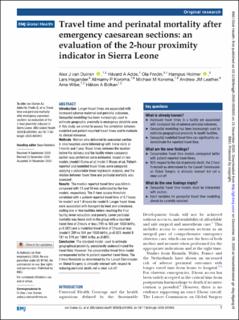| dc.description.abstract | Introduction Longer travel times are associated with increased adverse maternal and perinatal outcomes. Geospatial modelling has been increasingly used to estimate geographic proximity in emergency obstetric care. In this study, we aimed to assess the correlation between modelled and patient-reported travel times and to evaluate its clinical relevance.
Methods Women who delivered by caesarean section in nine hospitals were followed up with home visits at 1 month and 1 year. Travel times between the location before the delivery and the facility where caesarean section was performed were estimated, based on two models (model I Ouma et al; model II Munoz et al). Patient-reported and modelled travel times were compared applying a univariable linear regression analysis, and the relation between travel time and perinatal mortality was assessed.
Results The median reported travel time was 60 min, compared with 13 and 34 min estimated by the two models, respectively. The 2-hour access threshold correlated with a patient-reported travel time of 5.7 hours for model I and 1.8 hours for model II. Longer travel times were associated with transport by boat and ambulance, visiting one or two facilities before reaching the final facility, lower education and poverty. Lower perinatal mortality was found both in the group with a reported travel time of 2 hours or less (193 vs 308 per 1000 births, p<0.001) and a modelled travel time of 2 hours or less (model I: 209 vs 344 per 1000 births, p=0.003; model II: 181 vs 319 per 1000 births, p<0.001).
Conclusion The standard model, used to estimate geographical proximity, consistently underestimated the travel time. However, the conservative travel time model corresponded better to patient-reported travel times. The 2-hour threshold as determined by the Lancet Commission on Global Surgery, is clinically relevant with respect to reducing perinatal death, not a clear cut-off. | en_US |

